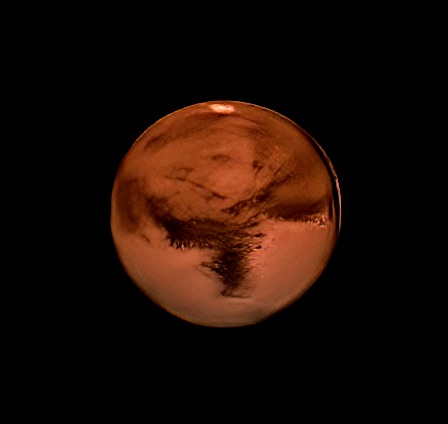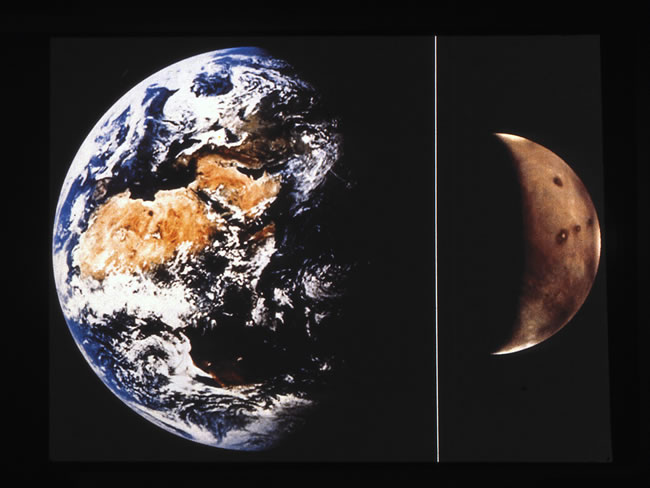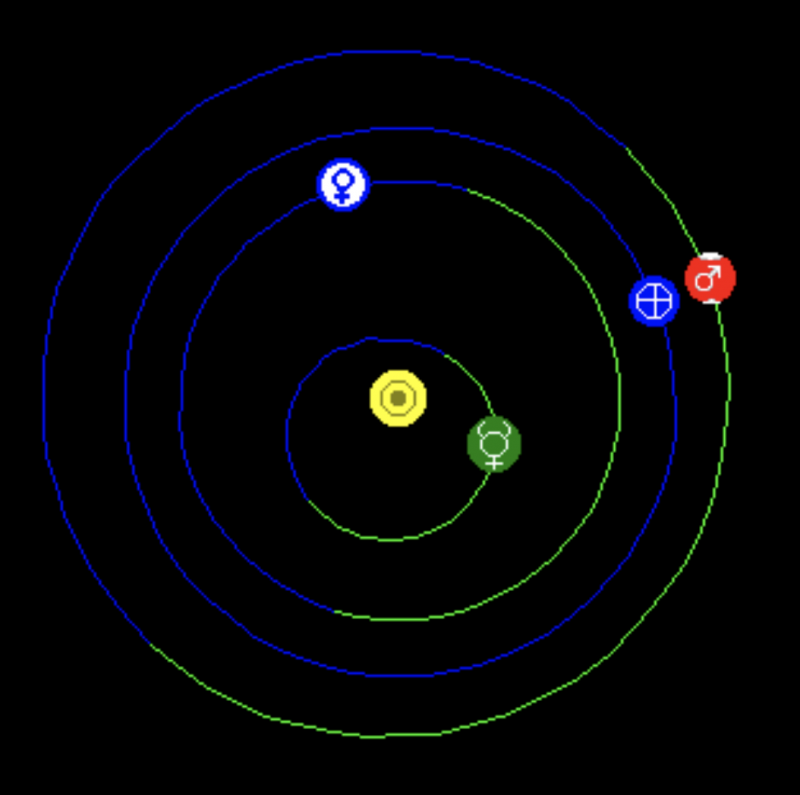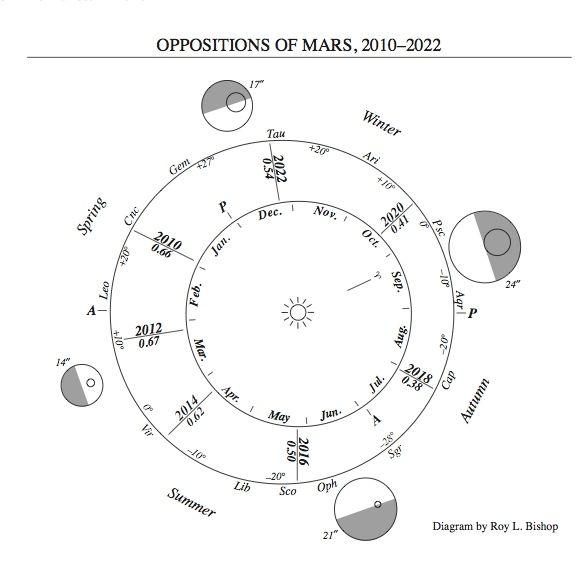

View at EarthSky Community Photos. | Abigail Atienza caught the waning gibbous moon and red planet Mars (on the right) with the northern lights along the Road to Nowhere, Iqaluit, Nunavut, Canada. September 6, 2020. Thank you, Abigail. For about a month surrounding mid-October 2020, Mars was brighter than all the stars, even brighter than Jupiter, normally the 2nd-brightest planet. As 2021 begins, Mars is dimming again. Why?
2018 was a good year to view Mars. So was 2020, especially around September, October and November. In both 2018 and 2020, Mars appeared as a blazing red dot of flame in our night sky. On the other hand, in 2019, Mars was mostly faint and barely noticeable in our sky. And – although in January 2021 Mars still shines as brightly as the sky’s brightest stars – Mars is growing rapidly dimmer and will appear quite dim throughout most of this year. Its dramatic swings in brightness are part of the reason the early stargazers named Mars for their god of war; sometimes, the war god rests, and sometimes he grows fierce!
Why? Why is Mars bright in some years, but faint in others? And what can you expect from the red planet in 2021? Keep reading to learn why the appearance of Mars varies so widely in our sky, making it one of the most interesting planets to watch.
Want photos of Mars at its best in 2020? Click here.
EarthSky 2021 lunar calendars now available! Order now. Going fast!
By the way, on January 19, 20 and 21, Mars is near the moon, as shown on the chart below. The moon can help you find Mars, which is high overhead when evening darkness falls. Notice Mars’ reddish color and steady light. It’s high in the sky now, when darkness falls. Once you identify Mars, you can watch it for months, as it fades in brightness.

The moon can guide your eye to Mars on January 19, 20 and 21, 2021. For about a week around this time, Mars and Uranus are in the same field of view with binoculars. Uranus is faint, though, barely within the limit for viewing with the eye alone, and moonlight will interfere with the view. Read more. Want a chart for this week, for your specific location on the globe? Try Stellarium.
As the weeks go by, you’ll notice Mars shifting toward the sunset. It’ll be fading in brightness as it nears the direction of the sun in our sky. By this northern spring (southern autumn), Mars will have faded so much that it’ll begin to appear inconspicuous among the brighter stars.
Finally, in this coming northern summer (southern winter), a much-faded Mars will be hovering near the sunset glare. It’ll appear to linger for many months in that position – close to the sun along our line of sight – and finally disappear into the sunset in August 2021.
Then Mars will be gone from our sky for some months. It’ll return by 2021’s end, though, to appear in the east before sunrise.
For specifics on Mars in the coming months, bookmark EarthSky’s planet guide.

View at EarthSky Community Photos. | Nancy Ricigliano captured Mars from Long Island, New York, on October 6, 2020, when it was closest to Earth. Thank you, Nancy. See more photos of Mars at its closest in 2020.

Mars isn’t very big, so its brightness – when it is bright – isn’t due to its bigness, as is true of Jupiter. Mars’ brightness, or lack of brightness, is all about how close we are to the red planet. It’s all about where Earth and Mars are, relative to each other, in their respective orbits around the sun. Image via Lunar and Planetary Institute.
To understand why Mars varies so much in brightness in Earth’s sky, first realize that Mars isn’t a very big world. It’s only 4,219 miles (6,790 km) in diameter, making it only slightly more than half Earth’s size (7,922 miles or 12,750 km in diameter).
Consider Mars in contrast to Jupiter, the biggest planet in our solar system. Jupiter is 86,881 miles (140,000 km) in diameter. More than 20 planets the size of Mars could be lined up side by side in front of Jupiter. Jupiter always looks bright, because it’s so big.
Not so for little Mars. Its extremes in brightness have to do with its nearness (or lack of nearness) to Earth.

Matt Pollack captured Mars from Little Tupper Lake in the Adirondacks of upstate New York in July 2018. Read more about this photo.
Mars orbits the sun one step outward from Earth. The distances between Earth and Mars change as both worlds orbit around the sun. Sometimes Earth and Mars are on the same side of the solar system and near one another. Sometimes, as was the case for much of 2019 and will be the case for much of 2021, Mars and Earth are on nearly opposite sides of the sun from each other, and so Mars appears faint.
Look at next few diagrams, below. The first shows Earth and Mars in their respective positions in their orbits around the sun in October 2020, when Earth and Mars were closest for this two-year period. The second shows Earth and Mars this month. The third shows Earth and Mars in August 2021, when Mars will be fading into the sunset glare.

This chart shows the relative positions of Earth (blue) and Mars (red) at the time of Mars’ last opposition on October 13, 2020. Around that time, Mars was bright in our sky and in the sky all night long. Image via Fourmilab.

This chart shows the relative positions of Earth (blue) and Mars (red) in mid-January 2021. Right now, Mars appears highest in the sky at sunset. It sets in the middle of the night. It’s still as bright as the brightest stars, but nowhere near as bright as it was in October 2020. Image via Fourmilab.

This chart shows the relative positions of Earth (blue) and Mars (red) in mid-August 2021. At that time, Mars will be far behind Earth in orbit. It’ll be faint and inconspicuous, very low in the west at sunset, fading into the sunset glare. Earth and Mars will be directly opposite each other (Mars at conjunction with the sun) on October 8, 2021. Image via Fourmilab.
Earth takes a year to orbit the sun once. Mars takes about two years to orbit once. Opposition for Mars – when Earth passes between Mars and the sun – happens every two years and 50 days.
So Mars’ brightness waxes and wanes in our sky about every two years. But that’s not the only cycle of Mars that affects its brightness. There’s also a 15-year cycle of bright and faint oppositions.
Due to that 15-year cycle, 2018 was a very, very special year for Mars, when the planet was brighter than it had been since 2003. Astronomers called it a perihelic opposition (or perihelic apparition) of Mars. In other words, in 2018, we went between Mars and the sun – bringing Mars to opposition in our sky – around the same time Mars came closest to the sun. The word perihelion refers to Mars’ closest point to the sun in orbit.
Maybe you can see that – in years when we pass between Mars and the sun, when Mars is also closest to the sun – Earth and Mars are closest. That’s what happened in 2018.
2003 was the previous perihelic opposition for Mars. The red planet came within 34.6 million miles (55.7 million km) of Earth, closer than at any time in over nearly 60,000 years! That was really something.
In 2020, Mars was still very bright at opposition. But it wasn’t as bright as it had been in 2018, or in 2003.
When is the next opposition of Mars? The next time Mars will appear at its brightest for that two-year period in our sky? You guessed it. 2022!

There’s a 15-year cycle of Mars, whereby the red planet is brighter and fainter at opposition. In July 2018, we were at the peak of the 2-year cycle – and the peak of the 15-year cycle – and Mars was very, very bright! In 2020, we were also at the peak of the 2-year cycle; however, Earth and Mars were farther apart at Mars’ opposition than they were in 2018. Still, 2020’s opposition of Mars was excellent. Diagram by Roy L. Bishop. Copyright Royal Astronomical Society of Canada. Used with permission. Visit the RASC estore to purchase the Observer’s Handbook, a necessary tool for all skywatchers. Read more about this image.
Bottom line: Mars alternates years in appearing bright and faint in our night sky. In 2018, our view of Mars was the best since 2003! In 2019, we were in one of Mars’ faint years. 2020 brought another bright year for Mars. And, for most of 2021, Mars will be faint and inconspicuous again.
Photos of bright Mars in 2018, from the EarthSky community
Photos of bright Mars in 2020, from the EarthSky community
from EarthSky https://ift.tt/2Puo0em


View at EarthSky Community Photos. | Abigail Atienza caught the waning gibbous moon and red planet Mars (on the right) with the northern lights along the Road to Nowhere, Iqaluit, Nunavut, Canada. September 6, 2020. Thank you, Abigail. For about a month surrounding mid-October 2020, Mars was brighter than all the stars, even brighter than Jupiter, normally the 2nd-brightest planet. As 2021 begins, Mars is dimming again. Why?
2018 was a good year to view Mars. So was 2020, especially around September, October and November. In both 2018 and 2020, Mars appeared as a blazing red dot of flame in our night sky. On the other hand, in 2019, Mars was mostly faint and barely noticeable in our sky. And – although in January 2021 Mars still shines as brightly as the sky’s brightest stars – Mars is growing rapidly dimmer and will appear quite dim throughout most of this year. Its dramatic swings in brightness are part of the reason the early stargazers named Mars for their god of war; sometimes, the war god rests, and sometimes he grows fierce!
Why? Why is Mars bright in some years, but faint in others? And what can you expect from the red planet in 2021? Keep reading to learn why the appearance of Mars varies so widely in our sky, making it one of the most interesting planets to watch.
Want photos of Mars at its best in 2020? Click here.
EarthSky 2021 lunar calendars now available! Order now. Going fast!
By the way, on January 19, 20 and 21, Mars is near the moon, as shown on the chart below. The moon can help you find Mars, which is high overhead when evening darkness falls. Notice Mars’ reddish color and steady light. It’s high in the sky now, when darkness falls. Once you identify Mars, you can watch it for months, as it fades in brightness.

The moon can guide your eye to Mars on January 19, 20 and 21, 2021. For about a week around this time, Mars and Uranus are in the same field of view with binoculars. Uranus is faint, though, barely within the limit for viewing with the eye alone, and moonlight will interfere with the view. Read more. Want a chart for this week, for your specific location on the globe? Try Stellarium.
As the weeks go by, you’ll notice Mars shifting toward the sunset. It’ll be fading in brightness as it nears the direction of the sun in our sky. By this northern spring (southern autumn), Mars will have faded so much that it’ll begin to appear inconspicuous among the brighter stars.
Finally, in this coming northern summer (southern winter), a much-faded Mars will be hovering near the sunset glare. It’ll appear to linger for many months in that position – close to the sun along our line of sight – and finally disappear into the sunset in August 2021.
Then Mars will be gone from our sky for some months. It’ll return by 2021’s end, though, to appear in the east before sunrise.
For specifics on Mars in the coming months, bookmark EarthSky’s planet guide.

View at EarthSky Community Photos. | Nancy Ricigliano captured Mars from Long Island, New York, on October 6, 2020, when it was closest to Earth. Thank you, Nancy. See more photos of Mars at its closest in 2020.

Mars isn’t very big, so its brightness – when it is bright – isn’t due to its bigness, as is true of Jupiter. Mars’ brightness, or lack of brightness, is all about how close we are to the red planet. It’s all about where Earth and Mars are, relative to each other, in their respective orbits around the sun. Image via Lunar and Planetary Institute.
To understand why Mars varies so much in brightness in Earth’s sky, first realize that Mars isn’t a very big world. It’s only 4,219 miles (6,790 km) in diameter, making it only slightly more than half Earth’s size (7,922 miles or 12,750 km in diameter).
Consider Mars in contrast to Jupiter, the biggest planet in our solar system. Jupiter is 86,881 miles (140,000 km) in diameter. More than 20 planets the size of Mars could be lined up side by side in front of Jupiter. Jupiter always looks bright, because it’s so big.
Not so for little Mars. Its extremes in brightness have to do with its nearness (or lack of nearness) to Earth.

Matt Pollack captured Mars from Little Tupper Lake in the Adirondacks of upstate New York in July 2018. Read more about this photo.
Mars orbits the sun one step outward from Earth. The distances between Earth and Mars change as both worlds orbit around the sun. Sometimes Earth and Mars are on the same side of the solar system and near one another. Sometimes, as was the case for much of 2019 and will be the case for much of 2021, Mars and Earth are on nearly opposite sides of the sun from each other, and so Mars appears faint.
Look at next few diagrams, below. The first shows Earth and Mars in their respective positions in their orbits around the sun in October 2020, when Earth and Mars were closest for this two-year period. The second shows Earth and Mars this month. The third shows Earth and Mars in August 2021, when Mars will be fading into the sunset glare.

This chart shows the relative positions of Earth (blue) and Mars (red) at the time of Mars’ last opposition on October 13, 2020. Around that time, Mars was bright in our sky and in the sky all night long. Image via Fourmilab.

This chart shows the relative positions of Earth (blue) and Mars (red) in mid-January 2021. Right now, Mars appears highest in the sky at sunset. It sets in the middle of the night. It’s still as bright as the brightest stars, but nowhere near as bright as it was in October 2020. Image via Fourmilab.

This chart shows the relative positions of Earth (blue) and Mars (red) in mid-August 2021. At that time, Mars will be far behind Earth in orbit. It’ll be faint and inconspicuous, very low in the west at sunset, fading into the sunset glare. Earth and Mars will be directly opposite each other (Mars at conjunction with the sun) on October 8, 2021. Image via Fourmilab.
Earth takes a year to orbit the sun once. Mars takes about two years to orbit once. Opposition for Mars – when Earth passes between Mars and the sun – happens every two years and 50 days.
So Mars’ brightness waxes and wanes in our sky about every two years. But that’s not the only cycle of Mars that affects its brightness. There’s also a 15-year cycle of bright and faint oppositions.
Due to that 15-year cycle, 2018 was a very, very special year for Mars, when the planet was brighter than it had been since 2003. Astronomers called it a perihelic opposition (or perihelic apparition) of Mars. In other words, in 2018, we went between Mars and the sun – bringing Mars to opposition in our sky – around the same time Mars came closest to the sun. The word perihelion refers to Mars’ closest point to the sun in orbit.
Maybe you can see that – in years when we pass between Mars and the sun, when Mars is also closest to the sun – Earth and Mars are closest. That’s what happened in 2018.
2003 was the previous perihelic opposition for Mars. The red planet came within 34.6 million miles (55.7 million km) of Earth, closer than at any time in over nearly 60,000 years! That was really something.
In 2020, Mars was still very bright at opposition. But it wasn’t as bright as it had been in 2018, or in 2003.
When is the next opposition of Mars? The next time Mars will appear at its brightest for that two-year period in our sky? You guessed it. 2022!

There’s a 15-year cycle of Mars, whereby the red planet is brighter and fainter at opposition. In July 2018, we were at the peak of the 2-year cycle – and the peak of the 15-year cycle – and Mars was very, very bright! In 2020, we were also at the peak of the 2-year cycle; however, Earth and Mars were farther apart at Mars’ opposition than they were in 2018. Still, 2020’s opposition of Mars was excellent. Diagram by Roy L. Bishop. Copyright Royal Astronomical Society of Canada. Used with permission. Visit the RASC estore to purchase the Observer’s Handbook, a necessary tool for all skywatchers. Read more about this image.
Bottom line: Mars alternates years in appearing bright and faint in our night sky. In 2018, our view of Mars was the best since 2003! In 2019, we were in one of Mars’ faint years. 2020 brought another bright year for Mars. And, for most of 2021, Mars will be faint and inconspicuous again.
Photos of bright Mars in 2018, from the EarthSky community
Photos of bright Mars in 2020, from the EarthSky community
from EarthSky https://ift.tt/2Puo0em

Aucun commentaire:
Enregistrer un commentaire